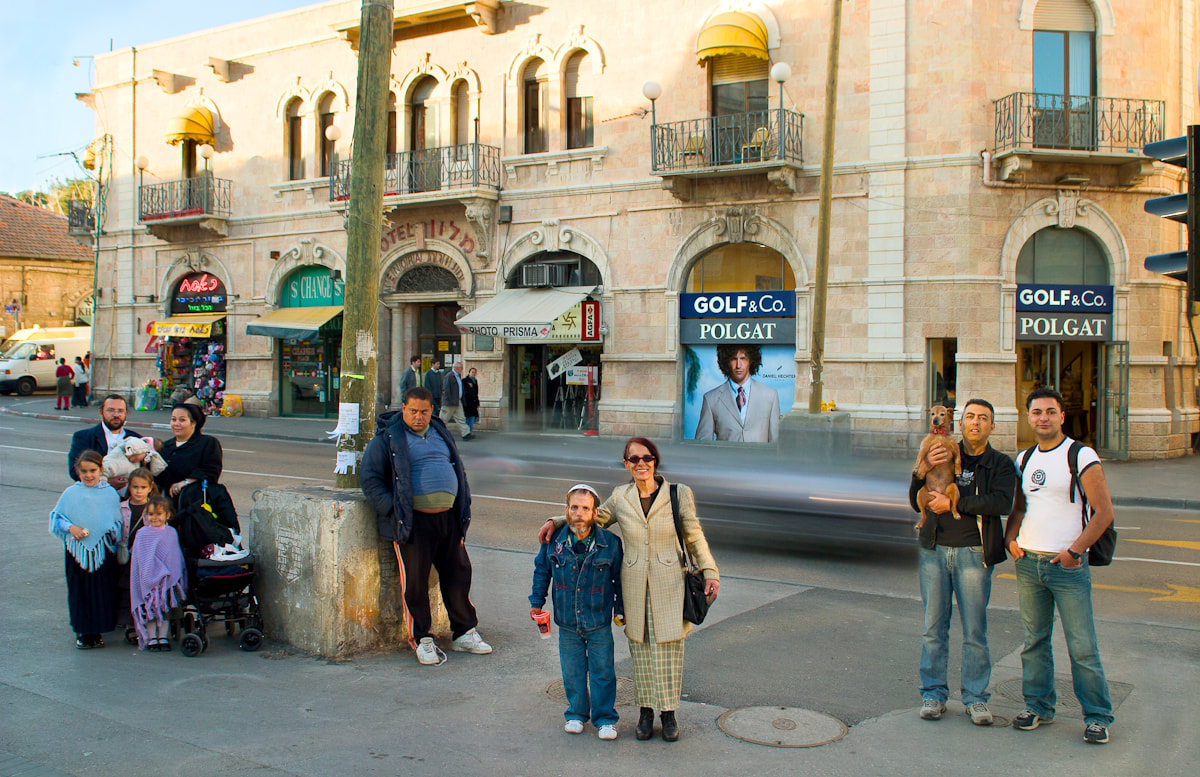|
It's the first photograph I made in The Jerusalem Show series, and it is significant as it has revealed several discoveries to me. To understand my excitement, I will introduce the discoveries through a story (after-all the process is most important): At the end of the first semester of my third year of study, I found myself without direction about the annual project I had to do. I tried to turn in a conceptual direction that didn't reveal anything to myself (for me it is obvious - if there is no discovery, there is no excitement, and it will not work). I went downtown to get inspired. I took my new digital reflex camera - a Canon 10D which had arrived from B&H two weeks earlier. (I purchased it to save the little money I earned from wedding photography due to the need to buy and develop the film, etc.) I was sure I'm just going to do sketch shots. None of us thought at the time that a camera like this can be taken seriously. Everybody said: "It doesn't have enough resolution... not enough color depth, etc." We were all Pixel Pipers from the first second.
I arrived at the city center and climbed on the stage in the center of Zion Square. I saw the Model and the man who suffered from Down-Syndrome. I quickly installed the camera on the tripod and took a photo. I wanted to have more people in the picture (I already had the experience from the "Sabbath Square" photo knowing how to assemble details from different shots). I wanted to do something weird, a bit like Fellini. In the distance, I saw an ultra-Orthodox family. I thought it could be nice if they appeared in the picture but, I had a problem, how to get them photographed?! - On the one hand, I can't move the camera away from its position, because then I won't be able to install the family in the final picture. On the other hand, I can't go to them and leave the camera behind because someone might steal it..., so I decided to shout and wave at them. They approached, and I asked if they would agree to stand for a family portrait. To my delight, they said: "Yes, where do you want us to stand?" I replied: "To the left of the concrete." The father: "And how do you want us to stand?" Me: "Just like you do for a wedding photo." (At the time I was working as an assistant to ultra-Orthodox wedding photographers, I used to run with a "Lomidine" flash, completing the lighting. At the beginning of a wedding, the whole family would gather for studio shots on sets with printed backgrounds such as palace halls and European forests. Even though the families always stood the same way, they did so in full devotion). The Orthodox family approached the scene, each knowing their exact location. There was a lot of noise around, and I had to shout while I was directing them- I wanted to see the baby. People heard my screams and came to see what was happening. Within five minutes, a queue of thirty people was waiting for me to take their picture. I photographed the people one after another, individuals and groups. Thanks to my new supernatural photographic ability - to see on the camera monitor where their predecessors stood, I directed them precisely to fit into the Decisive Moment. At one point, I saw the dwarf looking from the side. I asked him: "Would you like to be photographed?" He: "Who? Me?" Me: "Yes. I think you'll be wonderful in this picture." He stepped into the stage which is the scene. Suddenly a woman emerged and put her arm around his shoulders. I knew I earned a gift. (While I was working, a mix of photographers went through my mind: Richard Avedon, Garry Winogrand, Jeff Wall, Gabriel Bassilico). I photographed each person who was standing in line for me. I was tired and felt I had all I needed. Just before I moved the camera, a guy in a white shirt came up to me and said: "I want you to take my picture." (He didn't seem interesting to me. Also, just a minute ago, I was photographing a beautiful boy with blond hair holding two Saluki dogs). I told him: "I have to go, but for you I'll wait five minutes, if you bring someone else with you, I'll take your picture. After two minutes, he showed up with his friend. "Now you're photographing us!" he said. The guy he brought with him was even more boring, but he had a dog next to him. I asked: "yours?" He replied: "Yes!" I said: "If you hold him, I'll photograph you." When I returned home, I assembled the picture. I looked at the characters, and there they were: the Down-Syndrome and the Model, the Ultra-Orthodox family, the Gays with their dog, and an odd couple in the center. Everyone- standing and presenting themselves in front of their beautiful background. I said to myself, "This is the Jerusalem I know." |
List of photographs |

